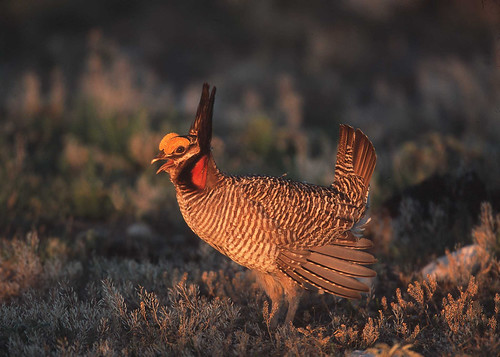
The population of the lesser prairie-chicken is on the rise, according to survey results released last week by the Western Association of Fish and Wildlife Agencies (WAFWA). Based on aerial surveys, biologists estimate the lesser prairie-chicken numbers about 29,000, a 25 percent increase from 2014.
WAFWA commissioned the annual survey, which showed increases in three of the four ecoregions the bird inhabits. The sand sage prairie region of southeastern Colorado showed the biggest gain with about a 75 percent increase between 2014 and 2015.
“This year’s increase, on the heels of last year’s 20 percent increase, is evidence of the species’ ability to rapidly recover from downturns as a result of drought and poor range condition,” said Ross Melinchuk, chairman of WAFWA’s Lesser Prairie-Chicken Council.
The lesser prairie-chicken population has declined over several decades because of loss of habitat, and in 2014, the U.S. Fish and Wildlife Service listed the iconic Great Plains bird as threatened. Severe drought in 2012 also had negative impacts on the bird.
Tracking the population of the lesser prairie-chicken is key to the species’ recovery. It provides a baseline and helps government agencies and other groups measure the impacts of conservation efforts.
USDA’s Natural Resources Conservation Service (NRCS) works with ranchers in Colorado, Kansas, Oklahoma, Texas and New Mexico to make conservation improvements to their land that benefit both the lesser prairie-chicken and the ranching operation. With 95 percent of the lesser prairie-chicken’s current range on private lands, these conservation efforts can have a tremendous benefit for the species.
“Lesser prairie-chickens depend very heavily on private lands for their habitats, and we’ve found that through sustainable grazing management, ranches can provide critical habitat for them,” said Christian Hagen, science adviser for the Lesser Prairie-Chicken Initiative (LPCI).
Through LPCI, NRCS has invested more than $20 million to help ranchers improve habitat and ranchland sustainability on nearly 950,000 acres since 2010.
“When ranchers restore habitat for the lesser prairie-chicken, it leads to other environmental benefits such as cleaner air and water and healthier soil, while also helping ranchers make their operations more efficient and productive,” said John Ungerer, LPCI coordinator for NRCS. “Keeping private lands agriculture profitable and in business while providing species conservation, Now, that’s a win-win.”
Key to LPCI is the partnership among NRCS, WAFWA and other groups. These groups provide a unified and targeted approach to prairie chicken management and conservation.
“By working collaboratively, our goal is that the lesser prairie-chicken’s population fully recovers while ensuring the nation’s working lands remain resilient,” Ungerer said. “We’ve seen wildlife successes across the country, and we’re confident in the power of voluntary conservation on private lands.”
This effort builds on the historic success of voluntary conservation practices on private lands that benefit wildlife while supporting working lands. Recently, because of proactive steps by private landowners to restore and improve habitat, listing was not required for the Bi-State sage-grouse or the Arctic grayling. The Oregon chub was the first fish delisted because of recovery, and delisting was recently proposed for the Louisiana black bear.
Learn more about NRCS’ wildlife conservation efforts. To get started with NRCS, visit your local USDA Service Center or www.nrcs.usda.gov/GetStarted.

